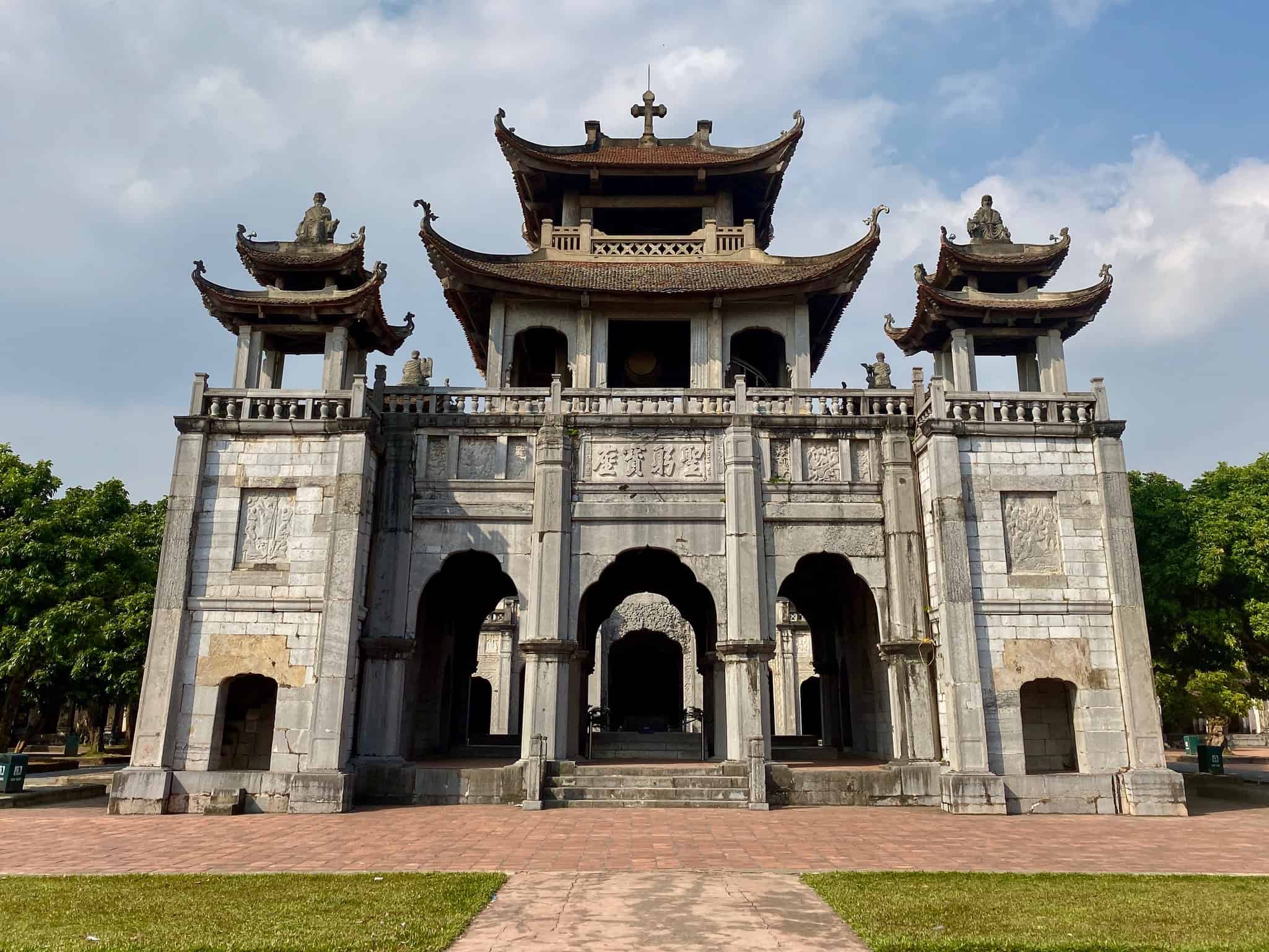If you’re traveling to Hanoi, Vietnam, and have a passion for stunning architecture, be sure to visit the Phat Diem Cathedral, located about two hours from the city. This remarkable cathedral is also famously featured in Graham Greene’s novel The Quiet American.
Situated approximately 123 kilometers (76 miles) from Hanoi, the Phat Diem Cathedral is an extraordinary architectural masterpiece built in the mid-1800s by Father Six, a Vietnamese Catholic priest. The cathedral complex includes a grand bell tower, the main cathedral, several smaller chapels, and serene grottoes. In 1972, the site endured damage when American bombers dropped eight bombs on the cathedral—yet it still stands today as a powerful symbol of resilience and faith.
Table of Contents
- The Architect – Father Tran Luc or Father Six
- Laying the Foundation of the Phat Diem Cathedral
- Procuring materials for the Phat Diem Cathedral
- Constructing the Phat Diem Cathedral
- Phat Diem Cathedral’s Entrance
- Phat Diem Cathedral’s Bell Tower
- The Phat Diem Cathedral
- The Phat Diem Chapels
- The Phat Diem Cathedral Grottoes
- Graham Greene’s 1951 Visit to Phat Diem Cathedral
- The 1972 American Bombing of Phat Diem Cathedral
- Visiting Phat Diem Cathedral
- Related Content
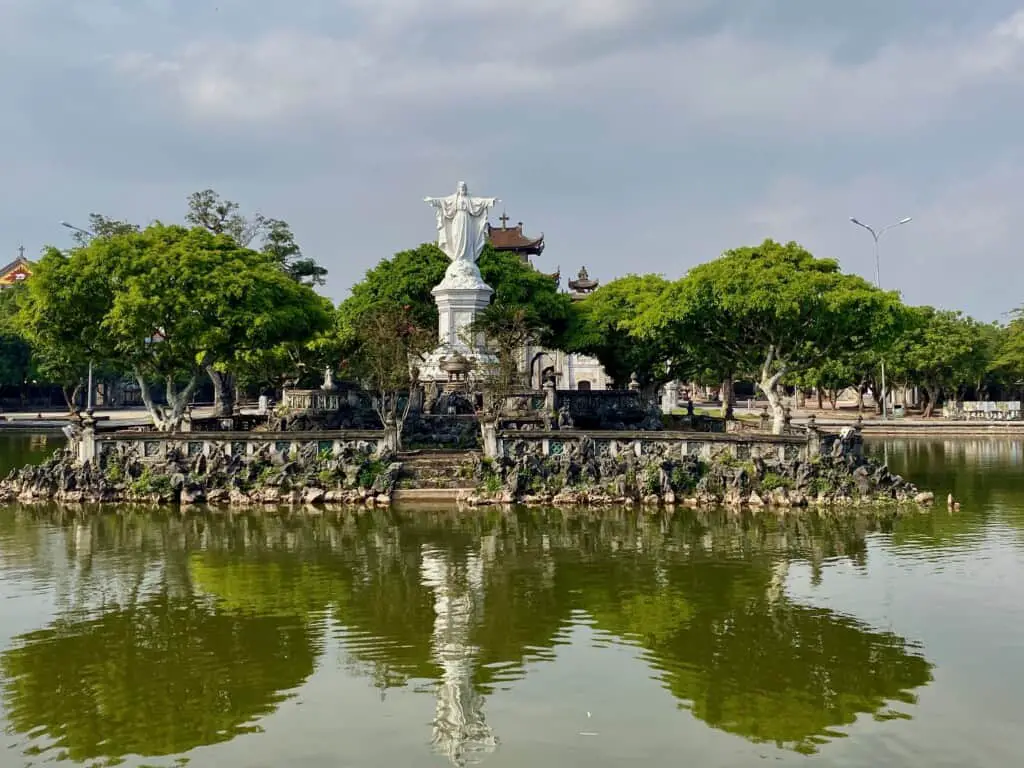
The Architect – Father Tran Luc or Father Six
The Phat Diem Cathedral architect was Father Tran Luc, or as he was known, Father Six. In French, he was called Pere Six; in Vietnamese, he is known as Cu Sau.
Father Six’s real name was Triem. He was born in 1825 in My Quan village in Nga Son district in Thanh Hoa province in North Vietnam. In 1858, he became a deacon, but before he could become a priest, he was arrested and sent to Lang Son Prison.
During this period, many Catholic priests were arrested and imprisoned as the Emperor of Vietnam did not like or trust the Catholics. He became known as Father Six when he was in prison.
In the 1860s, Father Six was imprisoned but was granted a brief visit to his hometown. During that short time, he seized the opportunity to be ordained as a priest. He was released from prison in 1863 and eventually appointed to lead the Phat Diem parish.
Father Six served as the pastor of the Phat Diem parish for 34 years. When he first arrived, the parish had around 2,000 Catholic members. By his death in 1899, that number had grown to over 10,000.
His impact was so profound that more than 40,000 people reportedly gathered to pay their respects at his funeral—a testament to the deep love and respect he had earned.
The construction of the Phat Diem Cathedral was a monumental task that spanned 34 years. Father Six spent ten years gathering materials and another 24 years overseeing the construction. Remarkably, the cathedral was built entirely with funds from local Vietnamese parishioners—many of whom were poor—without financial support from the French or foreign donors.
Had a foreigner designed the cathedral, it likely would have followed the European styles of the time. But Father Six envisioned something different.
The result is one of Asia’s most important and architecturally unique churches, blending Eastern and Western design elements into a harmonious whole. The structure stands as a symbol of how these two worlds can coexist in beauty and purpose.
Like all great architects and designers, Father Six was a visionary who dared to think beyond the conventions of his era. He understood his people and their cultural context and built a church that reflected both.
Beyond his architectural skills, Father Six was a man of many talents. He was well-versed in politics, Chinese literature, and Vietnamese poetry. He also composed prayers, catechisms, and educational materials—further cementing his legacy as a thoughtful and influential leader.
He was ahead of his time for a new type of evangelism called “inculturation. Inculturation is defined as:
“Inculturation is the term that Catholic leaders and theologians have used in recent decades to denote a process of engagement between the Christian Gospel and a particular culture. “
Dennis M. Doyle
Father Six was a forerunner in inculturation. Similar to the Jesuit Priest Matteo Ricci and his work in China and the Jesuit missionary Roberto de DeNobili and the work he did in India
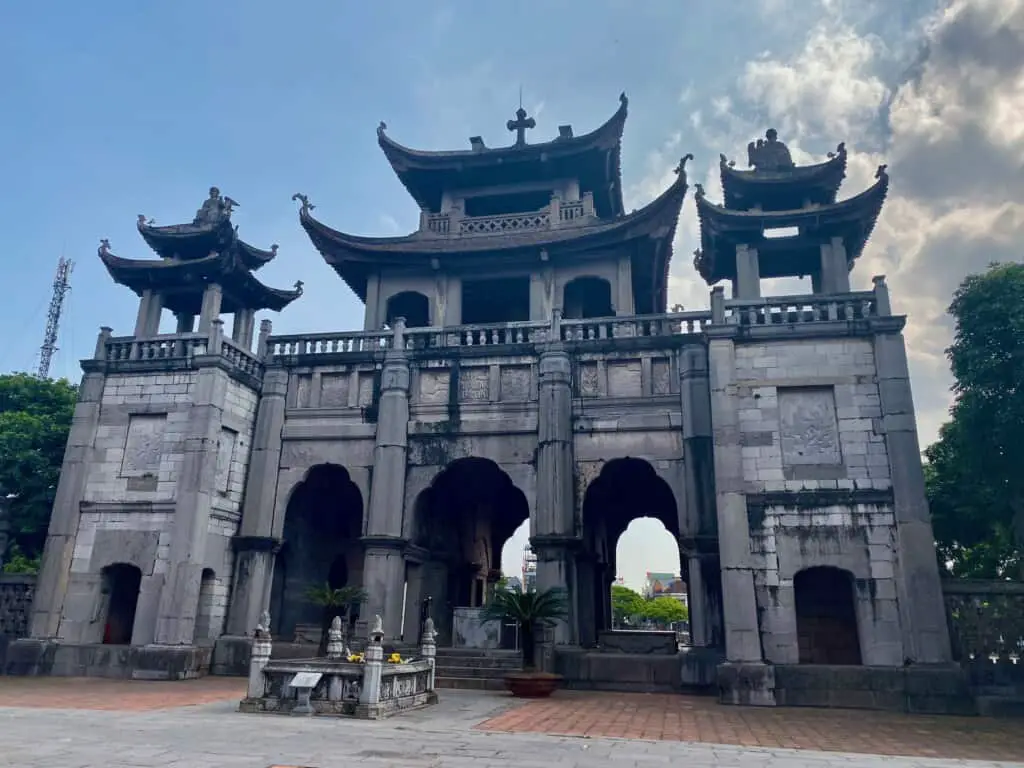
Laying the Foundation of the Phat Diem Cathedral
The land where Father Six built his church was originally swampy marshland, making construction a major challenge. Before any chapels could be built, the ground had to be carefully prepared and stabilized using only the materials and resources available at the time.
With no access to modern machinery, every step of the process was done by hand. Millions of bamboo stakes were driven approximately 30 meters deep into the earth until they could go no farther. Once the stakes were in place, layers of earth and gravel were poured over them and compacted by men and water buffalo. On top of this, bamboo rafts were laid—chosen not only for bamboo’s strength but also for its natural resistance to water.
All of this groundwork was completed before a single stone of the actual foundations was laid. And yet, these early efforts proved incredibly effective. The foundations have stood the test of time—strong, stable, and resilient.
Even when eight bombs were dropped on the cathedral by American forces in 1972 (see section below), the structure remained standing, a remarkable testament to the ingenuity and dedication behind its construction.
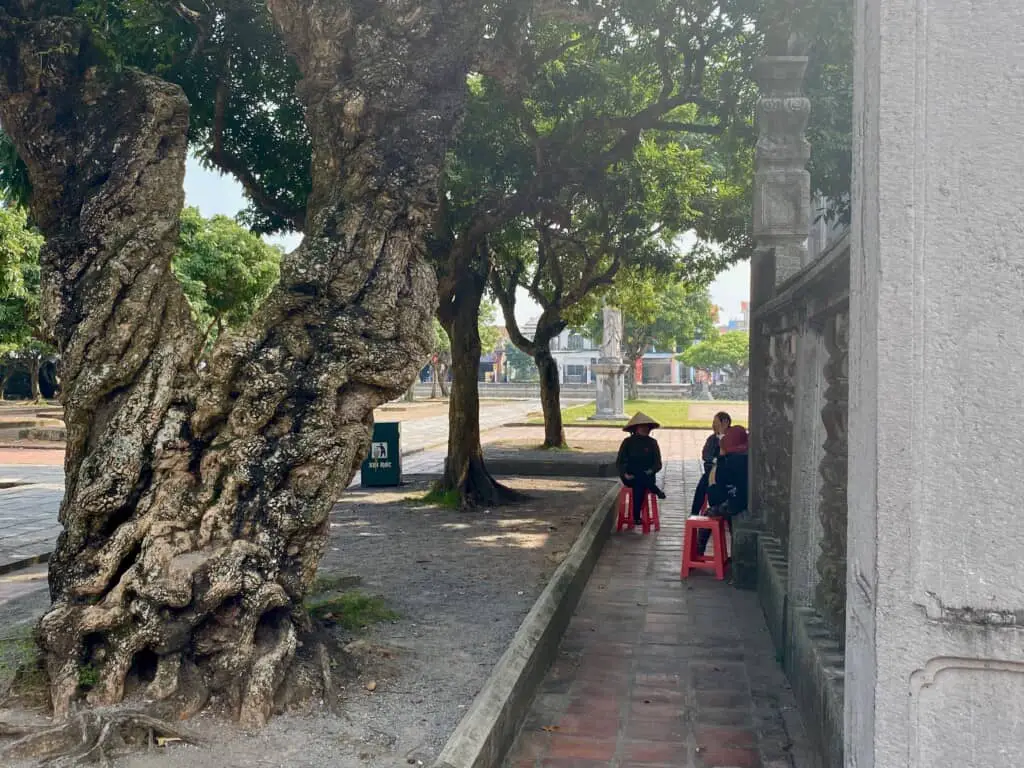
Procuring materials for the Phat Diem Cathedral
One of the greatest challenges Father Six faced was deciding which materials to use for building the cathedral. He needed options that were not only durable and long-lasting but also locally accessible and affordable.
However, the region around Phat Diem had limited natural resources suitable for construction. Even today, the area is better known for basket weaving and farming than for building materials. As a result, almost everything had to be transported from elsewhere, adding another layer of complexity to this ambitious project.
You can watch our video below to see more of the Phat Diem Chapel:
Here are some of the materials and where they had to come from:
- Stone – The stone came from the Thien Duong area, about 30 kilometers or 19 miles away.
- Marble – Marble came from Thanh Hoa Province, about 60 kilometers or 37 miles away.
- Timber – The timber had to come from several places. Some came from Nghe An Province, 200 kilometers or 124 miles away, Thanh Hoa Province, 60 kilometers or 37 miles away, and Son Tay Province, 150 kilometers or 93 miles away.
By today’s standards, these places may not seem that far, but remember, this was in the mid to late 1800s when transporting these materials would have been complicated. No wonder it took him over 10 years to gather and find the materials. It would have taken them quite a while to find, locate, and transport these materials to the construction site.
Some of the massive stone blocks used in the construction weighed up to 20 tons, while large timber trunks could weigh as much as 7 tons. These heavy materials were transported by bamboo rafts along the region’s network of waterways and canals.
At high tide, the rafts were brought close to shore, where the materials were unloaded. From there, teams of men and water buffaloes hauled the stones and timbers to the construction site—a remarkable feat of coordination, strength, and ingenuity.
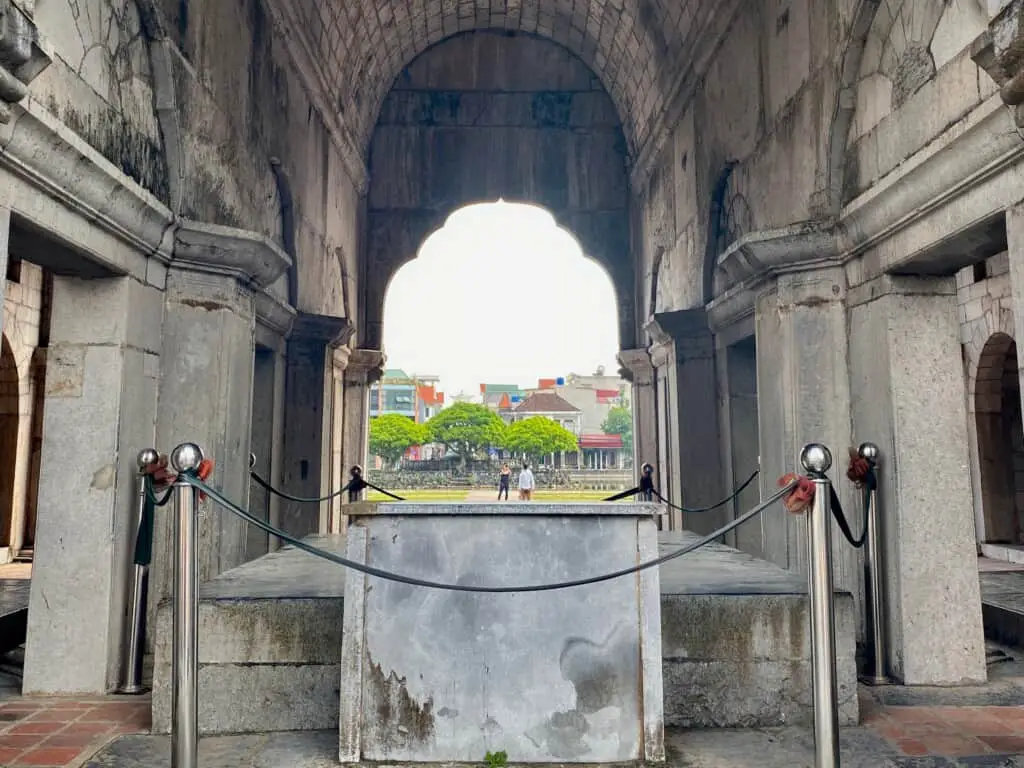
Constructing the Phat Diem Cathedral
Sourcing the materials was a major challenge—but so was the construction itself. Even today, the area surrounding the cathedral remains a relatively small town, especially when compared to major Vietnamese cities like Hanoi, Ho Chi Minh City, or Danang.
At the time, every building process had to be done entirely by hand, as no modern machinery was available. Even by today’s standards, constructing these cathedrals would be considered a complex task.
For Father Six and his community, it was an extraordinary and ambitious undertaking that stands as a testament to their vision, determination, and faith.
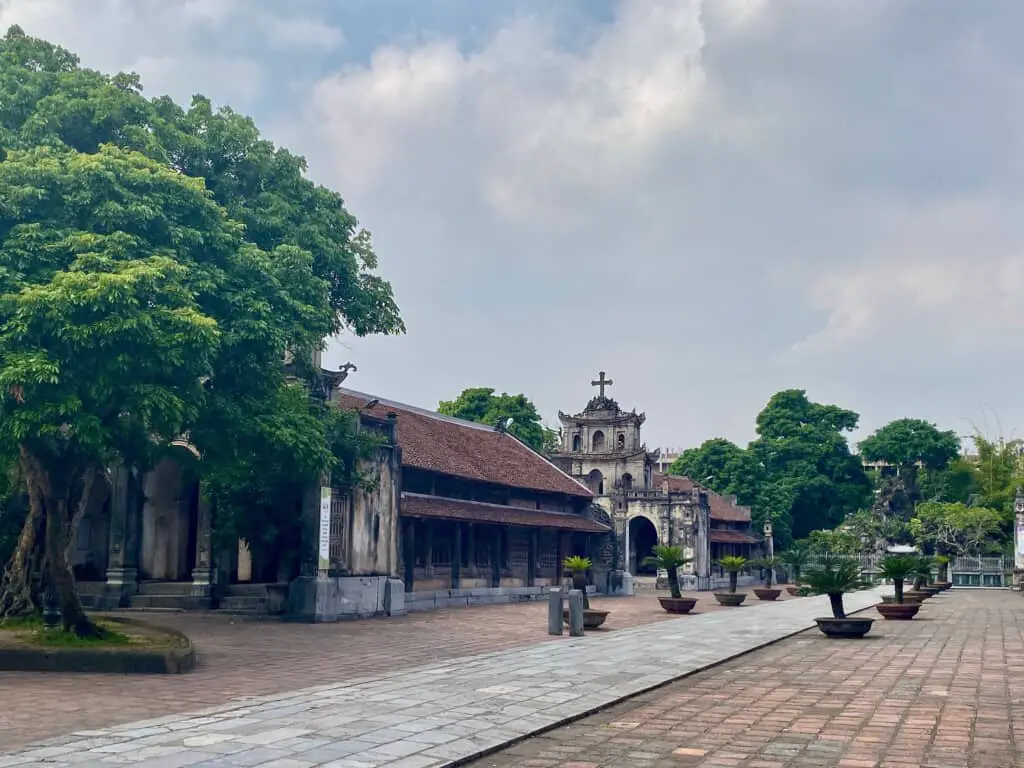
Here are some key details about the construction of the Phat Diem Cathedral:
Stonework – The massive stones used in the cathedral had to be manually dragged into position. At the time, cement was unavailable, so the stones were set using a traditional mortar made from sand and lime. Each block had to be carefully positioned and given time to settle firmly in place.
Woodworking – The stone porch at the cathedral’s entrance was specifically designed to aid in hoisting the enormous wooden beams into place. The construction was highly organized, with different groups of carpenters assigned to various sections of the cathedral. Remarkably, the foundation beams were ready after just three months of work, allowing for the placement of subsequent structural elements. Some of these beams weighed up to 25 tons each.
When you consider the immense effort required to source the materials and construct such a complex structure by hand, it becomes clear that the Phat Diem Cathedral is a true testament to Father Six’s extraordinary talents—not only as a priest but also as an architect, engineer, and visionary leader.
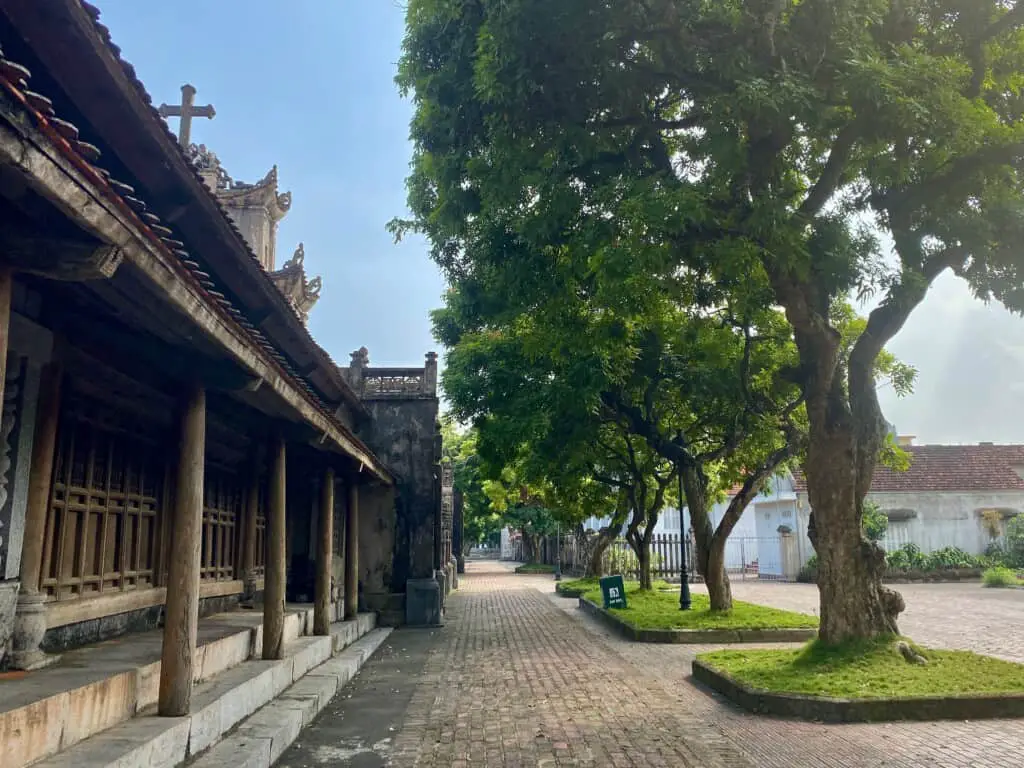
Phat Diem Cathedral’s Entrance
When I first entered the Phat Diem Cathedral grounds, the first thing that caught my eye was a serene pond with a small island at its center, featuring a statue of Christ with His hands raised in a welcome gesture.
The image immediately reminded me of the famous Christus statue at the Evangelical Lutheran Church in Denmark. However, in this version—called Christ the King—Christ’s hands are raised higher than in the original, giving the figure a more majestic and commanding presence.
What also stood out to me was the pond itself. In Vietnam, many Buddhist temples are designed with a pond in front, and with the water, the surrounding architecture, and the cross visible in the distance, the setting of the Phat Diem Cathedral initially feels very much like that of a traditional Vietnamese Buddhist temple.
Another detail visitors will notice is the threshold at the entrance to each building within the cathedral complex. Just like at a Buddhist temple, you must step over this threshold to enter—a practice rooted in Vietnamese culture as a sign of respect.
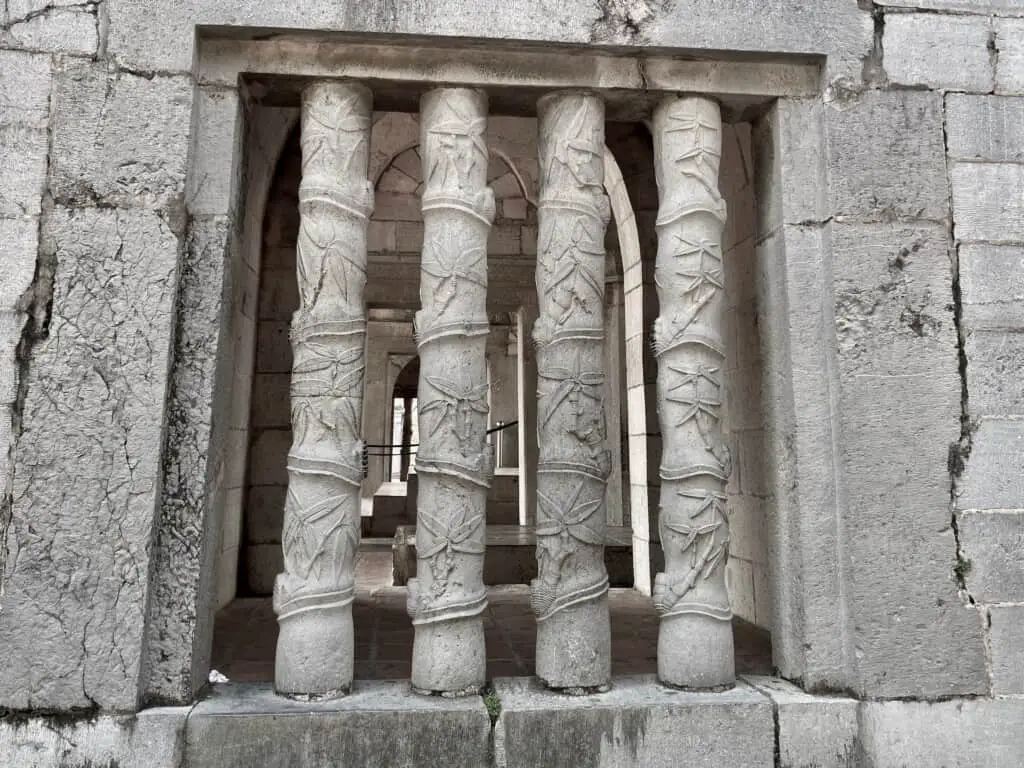
Phat Diem Cathedral’s Bell Tower
The bell tower is the structure near the lake and the first building you see when you enter the cathedral complex. The bell tower was built to represent a typical Vietnamese communal house in most Vietnamese villages.
Also, located in the back of the bell tower in the courtyard between the bell tower and one of the cathedrals is Father Six’s tomb.
The building is almost square and was built without any doors. Above the central entrance, you can see four large Chinese-style characters that translate to mean “precious seat of the Holy body.”
The smaller characters tell the date of the building, which translates as “Holy Thursday 1899.” A Latin inscription on the other side reads “Capella in Coena Domini,” meaning “Chapel for the Last Supper.”
The bell tower at Phat Diem Cathedral features a remarkably spacious interior. At the center of each section lies a large stone slab, traditionally used as communal seating where Vietnamese visitors sit cross-legged in quiet reflection or conversation.
The central stone slab is believed to have once belonged to the royal hall of the Tay Giai Citadel in Thanh Hoa Province, adding a touch of historical grandeur to the space.
Standing inside the tower, you can almost picture the generations of Vietnamese who gathered on these stone benches, discussing everything from Christian teachings to love, family, and daily life. One can’t help but wonder how many friendships were formed, how many hearts opened, and how many love stories began on those stones.
The walls of the bell tower are adorned with intricately carved stone reliefs of saints and delicately sculpted bamboo-like stone bars—an artistic blend of Eastern aesthetics and Christian symbolism. On the first floor hangs a large ceremonial drum, played only on Sundays and festival days to accompany the tolling of the great bell.
At the top of the tower, a massive two-ton bell is suspended, struck with a wooden ram. The bell’s deep, resonant sound can be heard up to 10 kilometers away. On clear days, the view from the top stretches to the seaside in the south and the mountains in the west.
The bell tower was the final structure completed in the Phat Diem complex, and many consider it to be the finest architectural achievement of them all—a fitting crown to Father Six’s monumental vision.
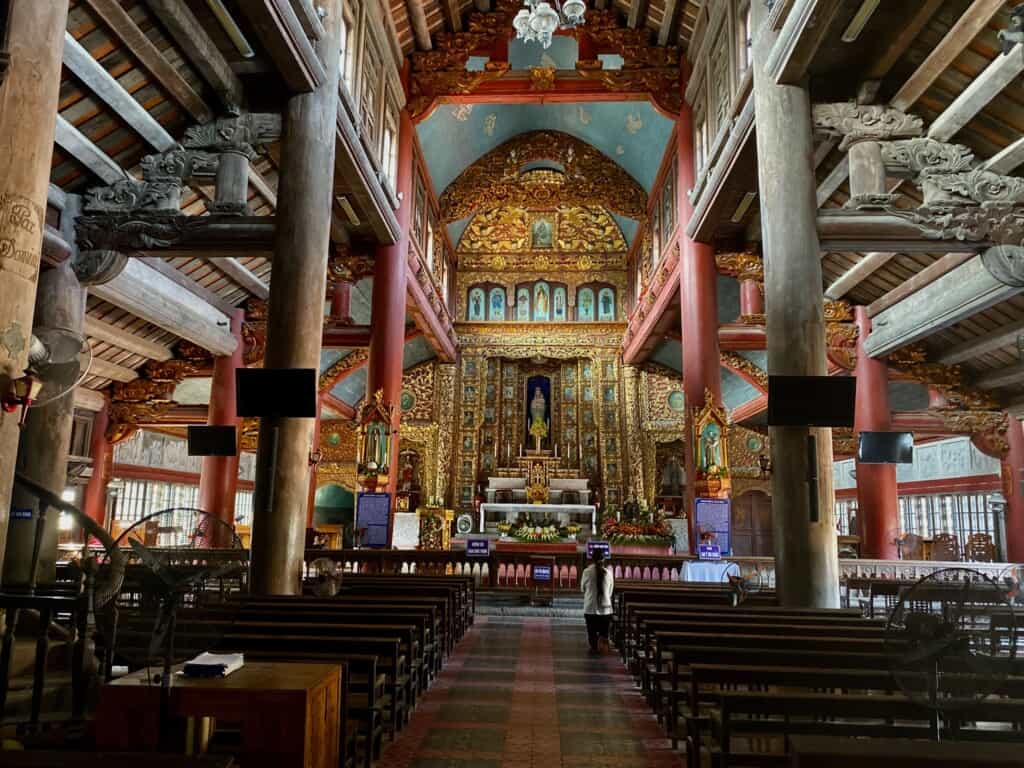
The Phat Diem Cathedral
Right behind the bell tower is the Phat Diem Cathedral. The cathedral has five smaller chapels and some grottoes surrounding it.
On the front of the stone facade of the Cathedral is a hymn in Latin to honor Mary, the mother of Jesus, and also a dedication of the Cathedral to Our Lady of the Holy Rosary. This was also signed by Father Six in 1891.
On the very top of the cathedral’s central tower are two angels holding up a cross, and some other angels are blowing trumpets along with four Chinese-style characters that say “foreboding of judgment day.”
Here are some facts about the outside and structure of the Cathedral.
- The towers are made of bricks.
- The five porches are made of stone.
- The central porch is a stone carved with rose bushes spreading its twigs among 17 angels.
- Above the stone porches are 15 stone reliefs representing different parts of Mary and Joseph’s life, also known as the rosary’s 15 mysteries.
- Five entrances are 9 meters deep (29 feet) and built of stone, leading to some carved doors.
- The roof rests on 52 wooden pillars, 16 of which are 11 meters high and 2.60 in circumference. These pillars weigh about 7 tons each.
- You can see two windows made of stone and a carved lion on the side of the outside wall.
When you enter the Cathedral, everyone should be impressed not only with the magnitude of the interior but also how quiet and reverent it feels.
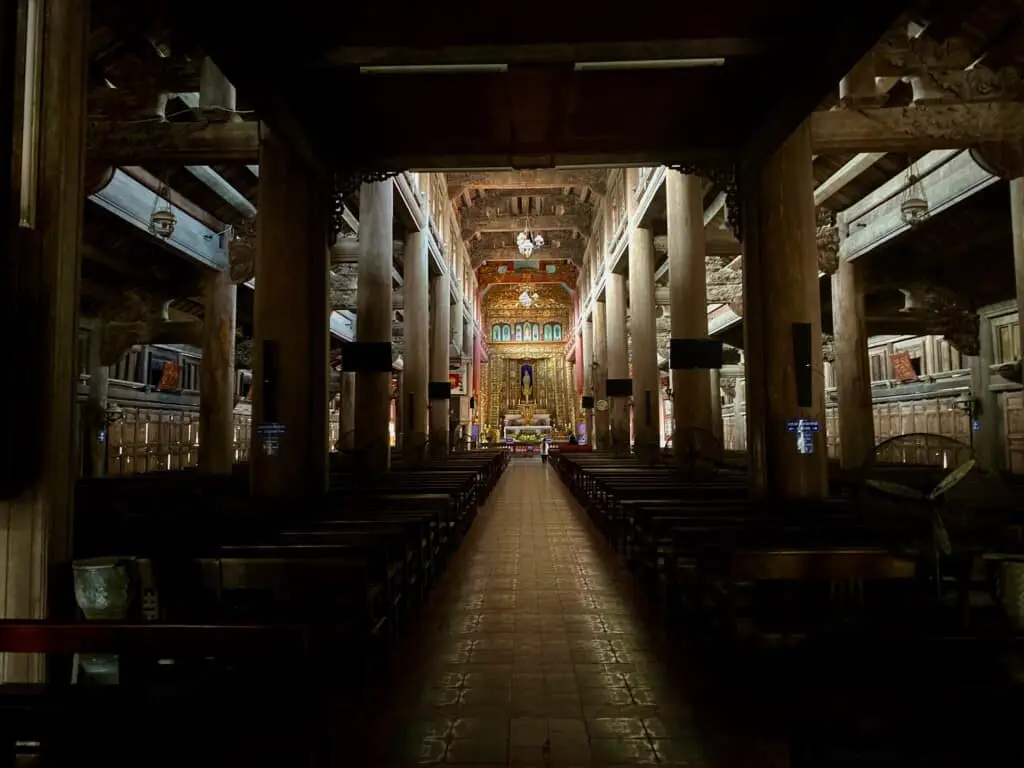
Here is some information about the inside of the Cathedral:
- Above each angel holding a holy basin are sentences in Latin, encouraging Christians with the right attitude they need to have when they come to pray.
- There are some magnificent hand-carved gold lacquer pillars. If you are interested in Vietnamese lacquer, read this blog on How to Manufacture Vietnamese Lacquer? by clicking here.
- A very prominent statue is “Our Lady with Infant Jesus.”
- Surrounding the statue are pictures of various Saints.
- On the glass windows are pictures of six martyrs; of these six martyrs, five are Vietnamese, and one is European.
- The top picture is “Our Lady giving the Rosary to St. Dominic.”
- A single slab of white stone cut the old altar in the rear. This altar is beautifully chiseled.
- The front altar is new and made of a single slab of stone. This altar was consecrated on 6th October 1991 during the 100th anniversary of the Cathedral.
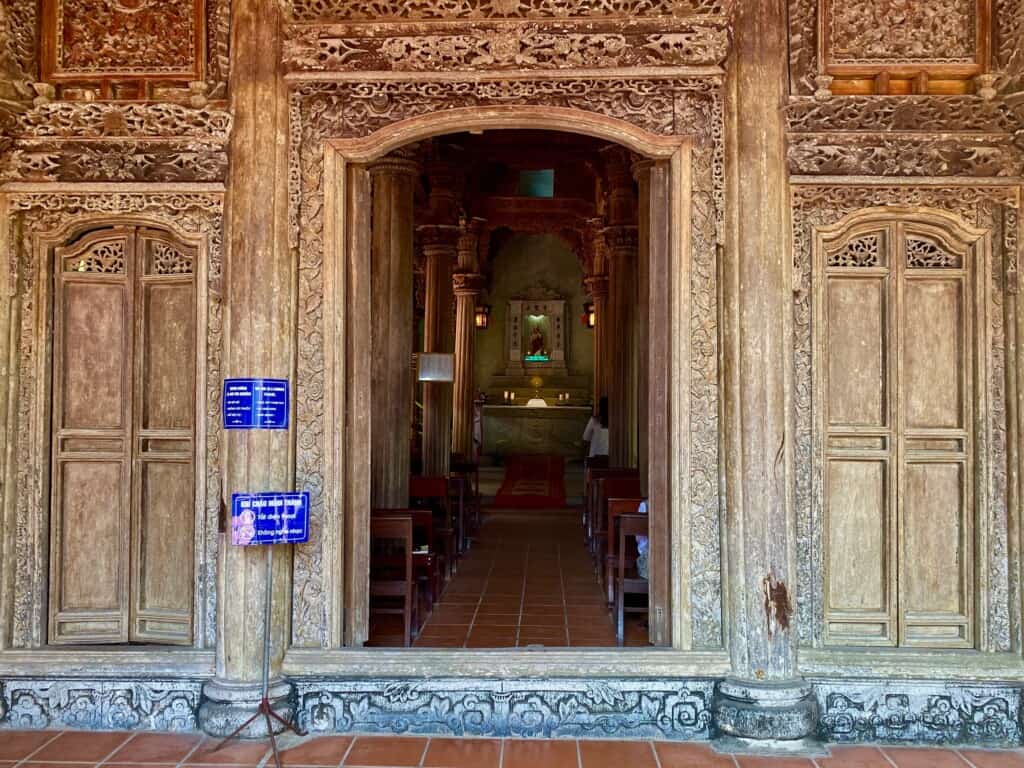
The Phat Diem Chapels
Father Six built 4 smaller chapels surrounding the Cathedral. A fifth chapel was the Stone chapel, built just a bit further away. Some refer to these smaller chapels as the “Ladies in Waiting.” Each one of these chapel structures is similar but also, at the same time, unique.
Here is some information about these five chapels.
Saint Joseph Chapel
The front chapel is on the west side and was built entirely of wood. On both walls of the choir are some stone reliefs depicting various episodes of Saint Joseph’s life. A choir inside a church is defined as being between the high altar and the nave, and it is used by the choir and clergy.
Saint Peters Chapel
Directly behind Saint Joseph’s is Saint Peter’s Chapel, built entirely out of jack wood. Jackwood is wood from the Jackfruit tree. Father Six dedicated this chapel to the patron Saint Peter.
The windows decorated with stone bars are reliefs that portray the twelve Apostles, whose names are written in the ancient Vietnamese script. The altar is a single block of stone weighing twenty tons.
The Immaculate Heart or The Stone Chapel
Perhaps the most famous of all the smaller chapels in the stone chapel. This chapel was built in 1883 and was the first to be built.
This chapel was made of stone, including all the floors, pillars, beams, walls, towers, and the altar. The outside facade is carved with stories, including the story of Sword Lake in Hanoi.
You can also see a Phoenix and a lion, smiling human faces. The central tower’s niche has engraved a prayer to the “Immaculate Heart of Mary” in four languages.
Even though this is all made from stone, the interior still looks light due to the high gloss marble decorations, beautiful windows, and sculptures.
The Sacred Heart Chapel
On the east side of the Cathedral is the Sacred Heart Chapel. This chapel has a three-tower facade and beautifully carved doors.
It was said that a French Official asked Father Six to bring these doors to Paris for an exhibition, but Father Six refused as he said the doors had already been given to God.
Saint Roch Chapel
This chapel was built in 1895 and was initially dedicated to Saint John the Baptist. The chapel was renamed after Saint Roch in gratitude for the area’s being spared from the cholera epidemic in 1923.
Except for the altar made of stone, the rest of the chapel is made of Jackwood.
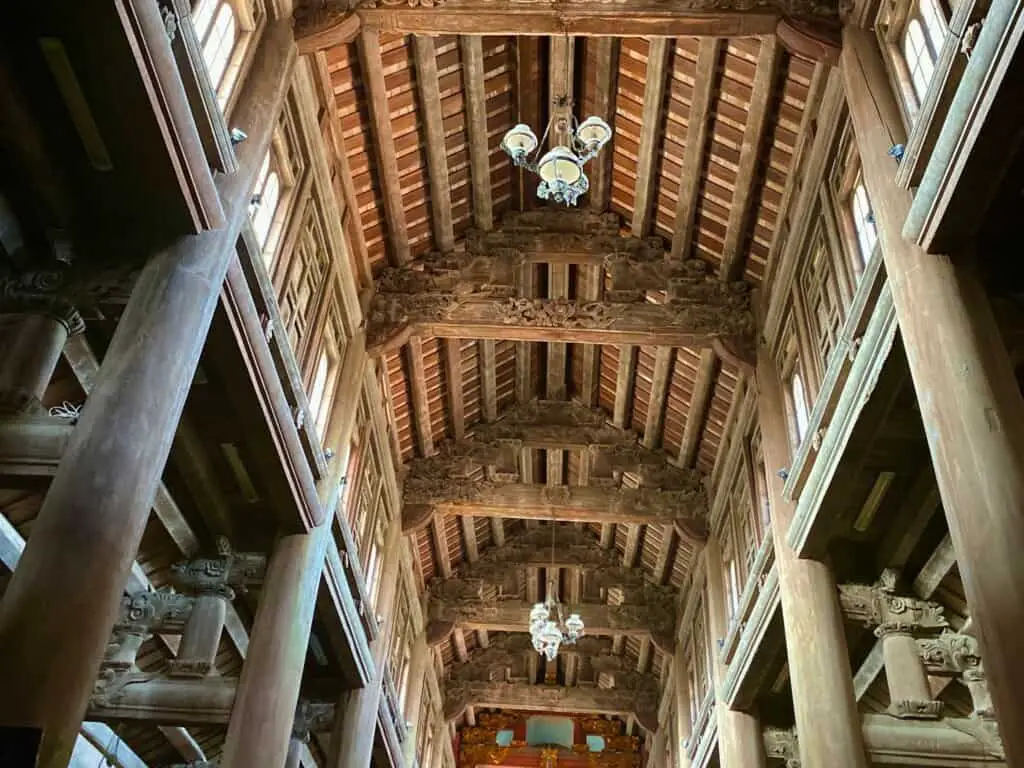
The Phat Diem Cathedral Grottoes
All around the Chapels and the cathedral area are also some grottoes. Here is some information on grottoes:
The Calvary Grotto
The Calvary grotto is in front of the Stone Chapel. The grotto has a statue of Christ on the cross at Calvary, and under the statue, you can see a cave that looks to represent Christ’s tomb.
The Bethlehem Grotto
The Bethlehem Grotto is east of the Calvary Grotto. This was originally named the Sepulchre Grotto, and it was built by Father Six in 1875 to help test the soil’s stability before starting construction.
The Lourdes Grotto
This is east of the Bethlehem Grotto. As you visit the Lourdes Grotto, you can stop to get a view of the Bishop’s house, where the right wing was built by Father Six over 100 years ago.
This grotto has some beautiful trees, and under some of the trees are the gravesites of two Parish Priests of Phat Diem, plus a layman who was martyred in the 19th Century.
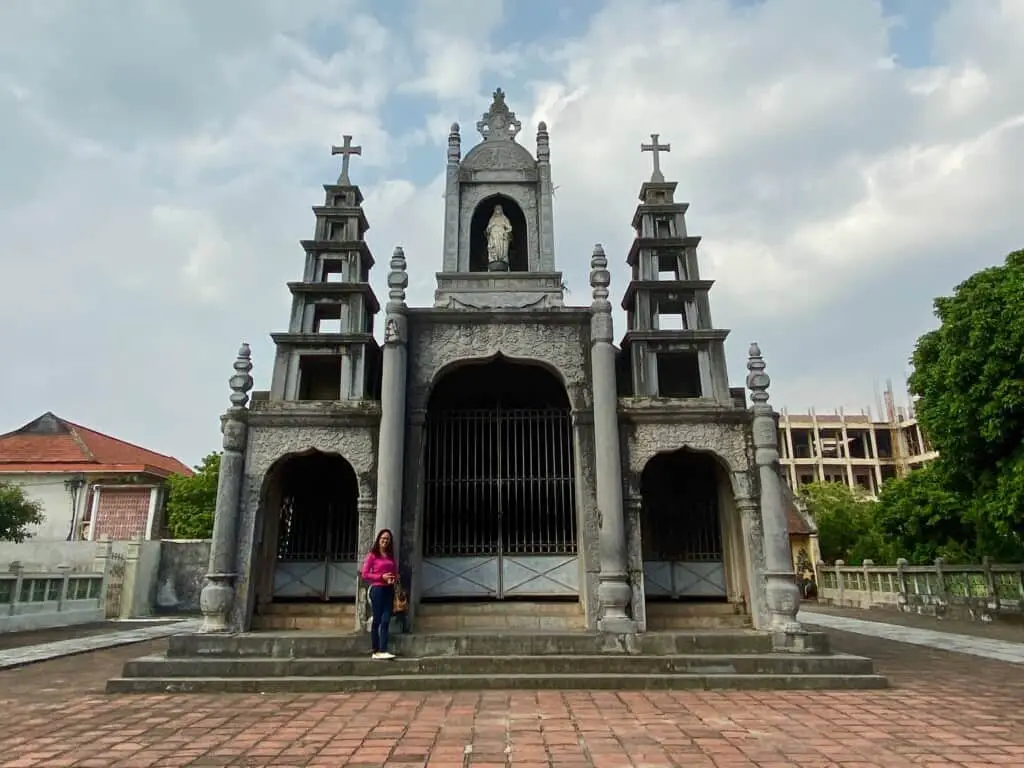
Graham Greene’s 1951 Visit to Phat Diem Cathedral
The renowned British author Graham Greene, best known for The Quiet American, was deeply intrigued by the Phat Diem Cathedral. In 1951, he visited the site with his friend Trevor Wilson, stationed at the British Embassy in Hanoi. Greene, a devout Roman Catholic, was drawn to the cathedral’s unique architecture and its symbolic role in Vietnam’s complex political landscape.
At the time of Greene’s visit, the region was caught in the turmoil of the First Indochina War, with the French and the Viet Minh locked in fierce conflict.
However, the area surrounding Phat Diem was controlled by a third force—Catholic Priest-Bishop Lê Hữu Từ. He governed the Diocese of Phát Diệm and the nearby Diocese of Bùi Chu. Bishop Từ commanded his militia of around 3,000 men and oversaw a population of approximately 500,000 Catholics and half a million Buddhists.
A staunch nationalist, Bishop Từ resisted both French colonial influence and Viet Minh hostility toward the Catholic community. His region became a rare stronghold of religious and political independence during a time of great instability.
Phat Diem Cathedral itself was not immune to the violence of the war. In 1953, French artillery shells struck the East Wing of the cathedral, causing part of the roof to collapse—an unfortunate reminder of how deeply the conflict impacted even sacred spaces.
In speaking about Greene and Wilson’s visit to Phat Diem, Kevin Ruane said:
“The Catholic Greene was captivated by Phat Diem, as was his friend and co-religionist Wilson. Greene also admired Tu’s independence: “my number-one enemy is the French,” Tu told him,“after which come the Communists.” On this first occasion Greene spent just thirty-six hours in this “medieval Episcopal principality” before returning to Hanoi on 1 February. “
Kevin Ruane
Graham Greene was captivated by the Phat Diem Cathedral, as it features prominently in his novel The Quiet American. The cathedral serves as one of the key settings in the book, reflecting Greene’s deep impression of its unique beauty and cultural significance.
When you visit Phat Diem and experience the architecture firsthand, it’s easy to understand why Greene found it so compelling. Its striking blend of Eastern and Western design elements and its symbolic presence in a turbulent era made it an unforgettable backdrop for his story.
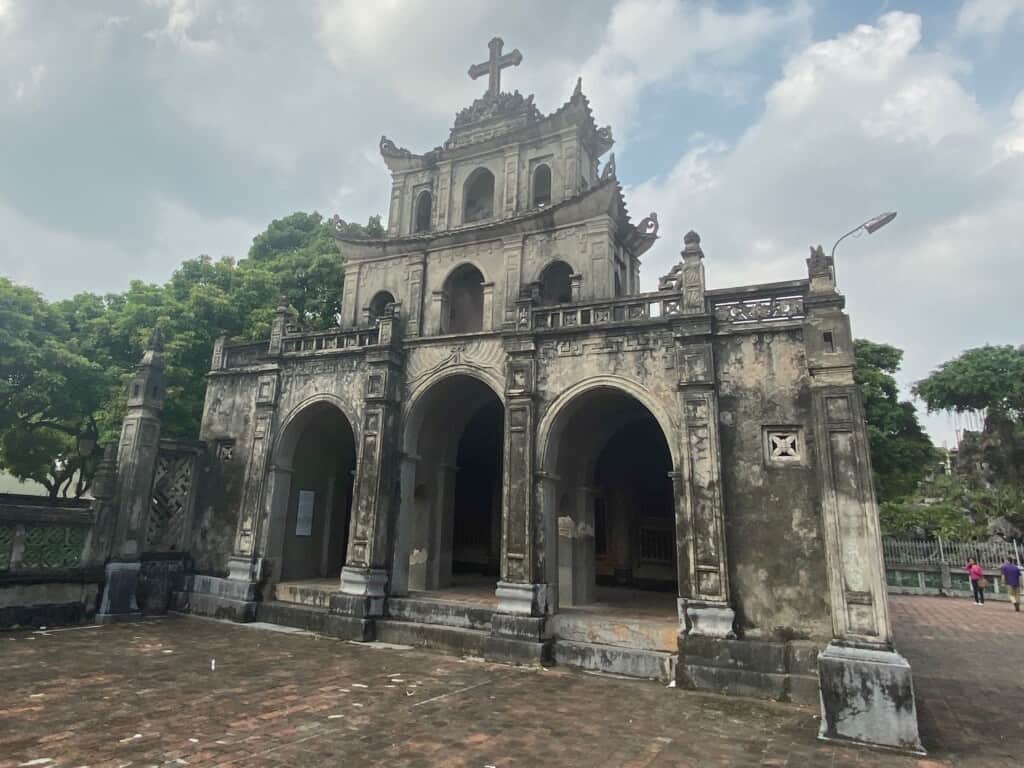
The 1972 American Bombing of Phat Diem Cathedral
On August 15, 1972, American bombers dropped eight bombs on the Phat Diem Cathedral complex in North Vietnam. The intended target was the entire cathedral grounds, but by sheer luck, several bombs missed their marks. Had all the bombs hit as planned, the entire complex likely would have been reduced to rubble.
The bombs struck from the bishop’s house to the pond area. One particularly destructive bomb exploded in the open space on the west side of the Cathedral. It completely flattened Saint Peter’s Chapel, caused Saint Joseph’s Chapel to tilt, and sent 36 massive stone slabs crashing to the ground.
The blast nearly tore off the Cathedral’s roof tiles and blew out most of the wooden doors—52 out of 56 were damaged. Intricate stone reliefs along the Stations of the Cross were also harmed.
Inside the Cathedral, the destruction continued. The main altar, adorned with gold and lacquer, was blanketed in dust and debris. The building itself tilted by 15 to 20 degrees. Only the strength of its stone façade prevented a total collapse.
This attack occurred during the height of the Vietnam War. In fact, just a few months later, in December 1972, the U.S. launched the infamous Christmas Bombing campaign, dropping 20,000 tons of bombs on North Vietnam.
Faced with this devastation, the Phat Diem Diocese had to make a difficult decision: wait until the war ended to begin repairs, or act immediately despite the risk of further attacks. Leaders feared that delaying the work might result in irreversible damage, particularly to the Cathedral’s precious gold-lacquered altar.
They chose to act. In October 1972, amid ongoing conflict, restoration work began.
Bomb craters were filled, new wood was cut to replace damaged doors, and tiles were sourced to repair the shattered roof. Around 200 people—most of them volunteers—joined the effort. Some carpenters worked for months without pay, sustained only by donated rice from the local community.
It took more than two years of dedication and sacrifice to restore the Phat Diem Cathedral complex from the damage inflicted by those eight bombs.
To read more about Vietnam’s history, you can read the blog entitled A Short History of Vietnam What You Need to Know by clicking here.
Visiting Phat Diem Cathedral
The Phat Diem Cathedral is truly worth a visit—not only for its striking architecture but also for its rich and compelling history. The Cathedral complex, with its unique blend of Eastern and Western design, tells a fascinating story of cultural fusion and resilience. It’s easy to understand why renowned author Graham Greene was so captivated by this remarkable site.
You don’t need a reservation to visit Phat Diem Cathedral. It remains an active place of worship, with regular Sunday Masses, and its gates are open to all visitors. There’s no admission fee, though donations are welcome and help support the upkeep of the historic buildings. From Hanoi, you can easily reach the Cathedral by taxi or private car, making it a convenient and meaningful day trip
You can check out these tour operators on Tripadvisors by clicking here. You can also ask your hotel to help you book a tour or a car.
What hotels are near Phat Diem Cathedral?
The Phat Diem Cathedral is in a tiny town, and there is not much in the area regarding food or other things to see.
Unless you have a reason to stay in the area as you want to visit the Cathedral over a few days, we recommend you stay in Hanoi and take a day trip to the Phat Diem Cathedral. Visiting the Cathedral in a day or half a day is easy.
At A Bus On A Dusty Road, we discuss travel, life, and ex-pat living. We are all about “Living Life As A Global Citizen.” We explore social, cultural, and economic issues and travel.
We would love to have you be part of our community. Sign up for our newsletter to keep up-to-date by clicking here. If you have any questions, you can contact me, Anita, by clicking here.
Listen to our Podcast called Dusty Roads. You can find it on all major podcast platforms. Try out listening to one of our podcasts by clicking here.
Subscribe to our A Bus On A Dusty Road YouTube Channel filled with great videos and information by clicking here.
Related Content
What U. S Companies Profited During The Vietnam War?
During the Vietnam War, many U.S. companies profited from the Vietnam war. Some of these companies were heading toward bankruptcy, but their involvement in the Vietnam War helped make them profitable. For many others, they earned millions of dollars each year in profits from the war that helped ensure they continued to be successful or even thriving companies.
By clicking here, you can discover What U. S Companies Profited During The Vietnam War?
Could America Have Won The Vietnam War?
America could not have won the Vietnam war as it never won the hearts and minds of the Vietnamese people. The Americans even had difficulty controlling the Vietnamese people in Southern Vietnam, as many were disillusioned with the Southern Vietnamese government. Ho Chi Minh, the leader of North Vietnam, fully understood that another foreign power would not control the Vietnamese heart and soul.
By clicking here, you can discover Could America Have Won The Vietnam War?
What Was The Main Reason For US Involvement In Vietnam?
The main reason for the involvement of the United States in the Vietnam War was the belief in the Domino theory; the Domino theory was a principle used to describe the effects on the world if Vietnam fell to communism. The idea was that if Vietnam became communist, the rest of Asia, New Zealand, and Australia would eventually become communist. At the time, American leaders felt they were fighting for the survival of democracy throughout the world.
By clicking here, you can learn more by reading What Was The Main Reason For U.S. Involvement In Vietnam?

